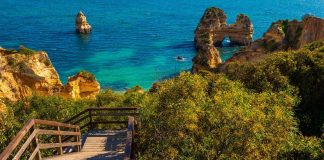Our raft bobs down the Atnarko River in British Columbia’s lush Great Bear Rainforest, one of Earth’s largest remaining temperate rainforests. As we round a rocky strand of riverbank, a young grizzly bear and her two cubs emerge from the canary grass. They march single file alongside us—a little too close for comfort.
Years of backcountry hiking—and established safety protocols for avoiding grizzlies—tell me to put more space between us. But a recent Canadian study, developed in collaboration with First Nations groups, suggests that humans may have once shared a closer relationship with bears, one based on resource reciprocity rather than fear.
A grizzly bear fishes for salmon in the Atnarko River in British Columbia’s Great Bear Rainforest.
Please be respectful of copyright. Unauthorized use is prohibited.
In an ecosystem experiencing habitat loss through logging and a province with a history of grizzly bear trophy hunting, the study’s findings could have wide implications for Indigenous-led conservation and wildlife tourism in British Columbia. The report supports the conventional wisdom that Indigenous traditions are effective conservation practices.
Zoom in to see other locations mentioned in the article.
A ‘kincentric’ view
In 2021, researchers from five coastal First Nations and scientists at the University of Victoria studied grizzly genetic groups on the central coast of the Great Bear Rainforest. Using DNA samples from hair snags, they made a stunning observation. Three distinct genetic groups of bears lived in areas that geographically aligned with the traditional territories of three Indigenous language groups: Tsimshian, Northern Wakashan, and Salishan Nuxalk.
The researchers concluded that these bear territories may have formed from shared resources with humans rather than “resistance factors,” or physical barriers such as a mountain range. In other words, the bears chose to stay in areas with plenty of food, water, and shelter, just like these Indigenous groups did. “The landscape is shaping bears and people in some similar ways,” says Lauren Henson, a biologist at the University of Victoria’s Raincoast Applied Conservation Science Lab and a study coauthor.
These First Nations petroglyphs carved into rocks in the Great Bear Rainforest are estimated to be over 5,000 years old and are considered sacred to the Nuxalk people.
Please be respectful of copyright. Unauthorized use is prohibited.
That conclusion seems to echo the “kincentric” view that some coastal First Nations have lived by for centuries—that all natural elements of an ecosystem are closely related. “Our elders said that bears taught us a lot about how to live here—what we could eat, where we could stay. We just have a lot of the same needs,” says Jennifer Walkus, a Wuikinuxv Nation elected council member and a study coauthor.
The findings challenge the efficacy of current government grizzly bear management practices, which don’t take genetic data into account. That’s an important distinction because monitoring for genetic differences can help improve the health of a population by alerting managers to high levels of inbreeding. It can also help grizzlies better adapt to threats and a changing ecosystem.
Equally important, the study makes a compelling case for integrating Indigenous ecological knowledge into conservation efforts, a recommendation now supported by a government mandate in Canada.
(A historic First Nations-led protest sparked a conservation movement.)
Science-backed Indigenous conservation practices
Not only does Indigenous knowledge contribute to more nuanced research, a 2021 study showed that it can lead to more successful conservation. Similar findings have been made around the world from Australia to Brazil. In British Columbia, Indigenous-led or sponsored research has been used to impact bear conservation policy, from ending trophy hunting in 2017 to protecting habitat on B.C.’s islands.
“Researchers are usually only there for a short period of time, whereas if you’re working with local nations who work within a territory, they get to see what happens with these animals over the full span of the year,” explains Walkus.
A young grizzly bear stops along the banks of the Atnarko River in the Great Bear Rainforest. Resorts in the forest, including Tweedsmuir Park Lodge, offer responsible bear-viewing outings, in accordance with British Columbia rules.
Please be respectful of copyright. Unauthorized use is prohibited.
The understanding that First Nations societies have gained over centuries of living along British Columbia’s central coast allows for a holistic approach to ecosystem management. “The government tends to look at all species from a very high level and manages them on a regional scale, whereas our people manage resources on the watershed scale,” says William Housty, conservation manager for the Heiltsuk Integrated Resource Management Department and coauthor of the language group study. “When we start to look at the health of all these different resources in one system, we can really paint a picture of how interconnected everything is and manage individual species accordingly.”
That philosophy is being applied to B.C.’s salmon population, a main food source for grizzlies that’s been decimated by overfishing and climate change. To restore a healthy population in their territory, the Wuikinuxv Nation is working with Fisheries and Oceans Canada (DFO) to determine carrying capacity and harvest limits that consider bears, fish, and people equally.
(Canada’s salmon are at risk. How can tourists help?)
This effort comes on the heels of multiple studies by the Wuikinuxv and the Raincoast Conservation Foundation, one of which found that people and bears can share salmon equitably in a way that benefits both. “Finding ways to manage not just for people but for all of the species on our land is critical,” says Walkus.
What does this mean for travelers?
The 2021 genetic grizzly study isn’t just filling in important context for conservation, it could lead to a richer wildlife watching experience for travelers at places such as Indigenous-owned Knight Inlet Lodge on Vancouver Island, in the Great Bear Rainforest, which helped establish the Commercial Bear Viewing Association of British Columbia (CBVA). The association also led the effort to end trophy hunting in British Columbia and now sets the standard for responsible bear viewing in the area.
“The experience of viewing a grizzly bear coupled with conservation messages in a tourism setting has potential to influence human attitudes and perceptions,” says Kate Field, a conservation scientist at the University of Victoria, who is collaborating with Indigenous researchers to study the effects of human presence on bear behavior.
“The study may help people understand how intricate and important the relationship is between people and bears and give people the opportunity to see that on the ground,” adds Housty. “The more people know and understand that, the better we can manage our relationship with bears and conserve their habitat.”
(These Indigenous women are reshaping Canada’s tourism industry.)
By learning this history, as well as the cultural significance of grizzlies to coastal First Nations, travelers may come away with a changed perspective on their own relationship with grizzly bears and the land. That’s important to Ellie Lamb, a bear guide at CBVA partner Tweedsmuir Park Lodge, who has spent years improving her knowledge about the keystone species from bear behavior experts and the Nuxalk people.
“First Nations know how to get along with bears; it’s been passed on from generation to generation,” she says. “They’ve witnessed, and I think as guides, we can learn from them.”
Back in the Great Bear Rainforest, Lamb leads me on a hike through Kettle Pond in Tweedsmuir Provincial Park. We stop before a sasquatch-sized print in the velvety moss beneath our feet. “It’s a stomp trail,” she explains, made by bears as they “stomp-walk” through the forest, leaving their scent and hair by scratching their backs on tree trunks.
“This was left recently,” she says, as she plucks bear hair from one of the trees. That familiar rush of adrenaline I felt while rafting returns, but quickly dissipates. As we follow the bear paw prints, just like First Nations people have been doing for centuries, their proximity elicits a feeling closer to kinship than fear. I see their traces in this ancient forest as a reminder of the connection coastal Indigenous peoples have with grizzlies.
Who better to lead the future of grizzly ecotourism than the people who have lived alongside these animals for millennia? “When we think about managing bears, it’s like managing ourselves.” says Walkus. “We were so closely bound together.”
How to visit
The Great Bear Rainforest stretches 250 miles from Knight Inlet to the Alaska Panhandle along the British Columbia coast. You can reach Tweedsmuir Provincial Park via a one-hour flight from Vancouver International Airport to Bella Coola. Pacific Coastal Airlines flies the route five days a week. Indigenous Tourism BC offers more ideas on how to travel responsibly in the province.
Grizzlies roam the forest throughout spring and summer, but for peak bear-viewing, plan your trip in early fall to coincide with the salmon run.
Hike with us: Heading into the great outdoors? We can help. National Geographic’s Trails Illustrated maps highlight the best places for hiking, camping, boating, paddling, and wildlife viewing in North America’s scenic, rugged frontiers and urban fringes. Created in partnership with local land management agencies, these expertly researched maps deliver unmatched detail and helpful information to guide experienced outdoor enthusiasts and casual visitors alike. Click here for a map of trails in western Canada, including British Columbia’s rainforests.Chloe Berge is a Vancouver-based writer who covers travel, conservation, and culture. Follow her on Instagram.













